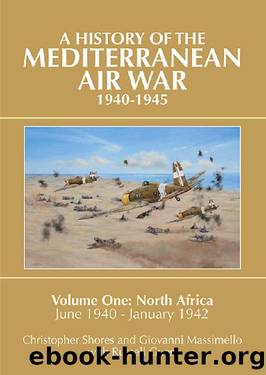A History of the Mediterranean Air War 1940â1945 by Christopher Shores

Author:Christopher Shores [Shores, Christopher]
Language: eng
Format: epub
Publisher: Grub Street Publishing
Published: 2013-11-28T23:00:00+00:00
To this total should be added several short-range TacR staffeln equipped with Hs 126s and (increasingly) Bf 110s, an air/sea rescue staffel with Do 24 flyingboats, and some liaison units with Fi 156s. At this stage of the war large numbers of Ju 52/3m transports could be made available from home-based units at short notice, despite the losses which had been suffered during the Cretan invasion.
To command and direct the much larger forces now being prepared to move to the area, the first priority was perceived to be an overall commander. The job was offered to Feldmarschall Albert Kesselring â âSmiling Albertâ to his subordinates â who was to take up the position of Oberbefelshaber Süd (Commander-in-Chief South). As such he would have precedence over all other German commanders in the area of (almost) all forces â and his appointment came as a not altogether welcome surprise to his Italian allies.
Albert Kesselring had served in World War I as an artillery man and was not an airman. However, he was perceived to be an excellent organiser, being qualified as a staff officer. Recruited into the clandestine air staff in 1933, he served initially as a GenMaj i/c administrative services. When Gen Walter Wever, the Luftwaffeâs âprophetâ of strategic air power was killed in a flying accident in June 1936, Kesselring replaced him as chief of air staff. As an ex-soldier, he did not espouse the same views as Wever, and was amongst those who were instrumental in redirecting the Luftwaffe as an essentially tactical force.
In 1937 he took command of the new Luftflotte 1 as a GenOberst, leading this force during the invasion of Poland in September 1939, where he became enthused by the apparent efficacy of the Stuka dive-bomber as an instrument of air power. He then moved to command Luftlotte 2, which he led throughout the Western European campaign of May-June 1940, the Battle of Britain during the summer of that year, and then the Operation Barbarossa invasion of the Soviet Union. By that time he had been promoted feldmarschall.
Taking up his new post on 28 November 1941, Kesselring soon found that his life would not necessarily be an easy one. He was to be followed in early December by II.Fliegerkorps under GenOberst Bruno Lörzer, which had been part of his command in Luftflotte 2, although its composition would differ somewhat from that appertaining to its service in Russia.
Kesselring would now command both II. and X.Fliegerkorps, and Fliegerführer Afrika, which would now come under the former. Initially he instructed Geisler to become responsible for the neutralisation of Malta until the new command could arrive. Lörzer had been one of the more successful fighter pilots of the Great War, ending that conflict as a hauptmann in command of the elite JG III, equipped with BMW-engined Fokker D.VIIs â arguably the best, and certainly one of the best fighter aircraft of that war. He had been credited with 44 aerial victories and remained a close personal friend of Hermann Göring, who had been an immediate contemporary.
Download
This site does not store any files on its server. We only index and link to content provided by other sites. Please contact the content providers to delete copyright contents if any and email us, we'll remove relevant links or contents immediately.
| Automotive | Engineering |
| Transportation |
Whiskies Galore by Ian Buxton(41882)
Introduction to Aircraft Design (Cambridge Aerospace Series) by John P. Fielding(33064)
Small Unmanned Fixed-wing Aircraft Design by Andrew J. Keane Andras Sobester James P. Scanlan & András Sóbester & James P. Scanlan(32744)
Craft Beer for the Homebrewer by Michael Agnew(18145)
Turbulence by E. J. Noyes(7940)
The Complete Stick Figure Physics Tutorials by Allen Sarah(7310)
Kaplan MCAT General Chemistry Review by Kaplan(6867)
The Thirst by Nesbo Jo(6830)
Bad Blood by John Carreyrou(6555)
Modelling of Convective Heat and Mass Transfer in Rotating Flows by Igor V. Shevchuk(6391)
Learning SQL by Alan Beaulieu(6212)
Weapons of Math Destruction by Cathy O'Neil(6148)
Man-made Catastrophes and Risk Information Concealment by Dmitry Chernov & Didier Sornette(5924)
Digital Minimalism by Cal Newport;(5667)
Life 3.0: Being Human in the Age of Artificial Intelligence by Tegmark Max(5476)
iGen by Jean M. Twenge(5367)
Secrets of Antigravity Propulsion: Tesla, UFOs, and Classified Aerospace Technology by Ph.D. Paul A. Laviolette(5310)
Design of Trajectory Optimization Approach for Space Maneuver Vehicle Skip Entry Problems by Runqi Chai & Al Savvaris & Antonios Tsourdos & Senchun Chai(5011)
Pale Blue Dot by Carl Sagan(4913)
